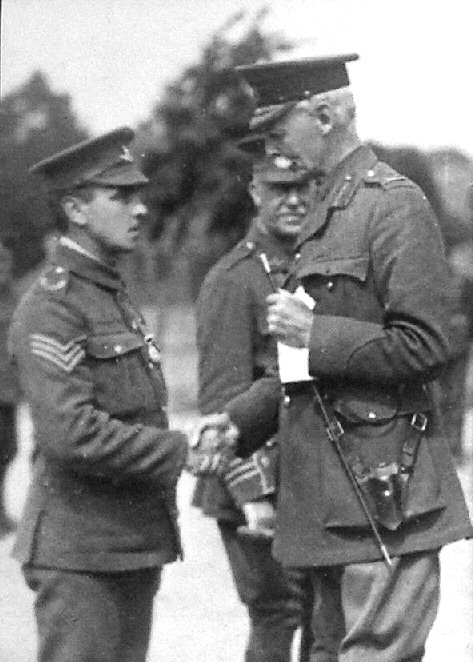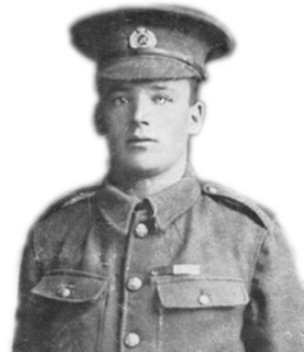Russian Awards and Decorations
The following Imperial Russian awards were made to soldiers of the Worcestershire Regiment for gallantry or meritorious service. They are recorded in the London Gazette, indicating the granting of the award or decoration by the Russian Tsar, and intimating the British sovereigns permission for it to be accepted and worn by the recipient.
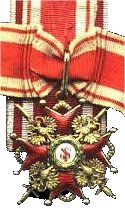 |
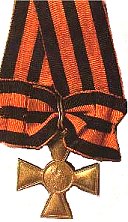 |
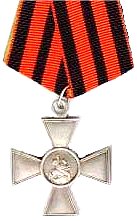 |
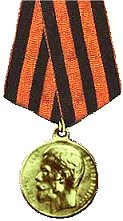 |
Order of St. Stanislas 3rd Class (with swords) |
Cross of St. George (1st Class) |
Cross of St. George (3rd Class) |
St. George Medal (2nd Class) |
Order of St Stanislas
Founded in 1765 as a Polish order and named after Stanislas August Poniatowsky the last King of Poland. By statute confirmed by Nicholas I in 1831, the Order of St Stanislas was to be included among the Russian Orders, it is in three classes:
1st class : Badge of the Order on a Sash, and a Breast Star.
2nd class: Badge of the Order worn on a necklet.
3rd class : Badge of the Order smaller and worn on the breast
The Order of St Stanislas consists of a Bath cross edged in gold and enamelled red or in some cases black, with a double-backed gold eagle in each angle. Obverse a circular wreath of green laurel holds the white enamelled medallion upon which the entwined SS appears in red. Reverse is plain gold except for the central medallion which appears exactly as that on the obverse. Can be awarded with swords (as for military awards) and in special cases the badge was surmounted by the Imperial crown.
During the First World War a little over 350 Orders of St Stanislas were awarded to British officers.
Cross of St. George
Founded by Alexander I in February 1807 as St George Cross was originally in one class to reward non-commissioned officers and enlisted men for bravery performed in action against the enemy. The Cross of Sr. George is associated with the Order of Saint George, but for enlisted men and NCO's. In February 1856 to mark his accession, Alexander II decreed that the St George Cross should be in four classes to reward bravery performed by other ranks.
Like the Order of St. George, the Cross of St. George was awarded for acts of distinction under arms. An enlisted man or NCO would be awarded the 4th class cross for his first brave act. A second notable act could then bring him the 3rd class cross, etc. The first class and second class were in gold, the first class with a bow on the ribbon. The third and fourth classes were in silver, the third class marked by a bow. The ribbon was the same as for the Order of Saint George.
Over two million Saint George Crosses were distributed during the First World War and before the abdication of the tsar., going to soldiers, nurses and members of the Red Cross. Commanders in the field could award the St. George Cross on the spot.
St. George Medal
Instituted in August 1878 in four classes as the Medal for Bravery awarded to non-commissioned officers and enlisted men for bravery during peace or war. In 1913 the title of the medal was changed to "St George Medal for Bravery". The medal can be awarded to civilians for bravery during times of war.
Awarded for merit in combat. Associated with the Order of St. George, but ranking below that of the the Cross of St. George.
The St. George Medal came in four classes. Gold medallions for 1st and 2nd class (shown above). Silver medallions for 3rd and 4th. A bow on the ribbon denoted 1st class and 3rd. The medal was awarded for merit to other Allied soldiers as well as Russians.
Obverse the bust of the reigning Emperor with his title. Reverse centre in two lines the wording FOR BRAVERY, below the recipient's impressed award registration number followed by the class of the award.
During the time of the Provisional Government (March - November 1917), the bust of the Emperor was replaced by St George slaying the dragon.
First World War (1918-1920)
Order of St. Stanislas with swords - (Russian) |
|||||
Surname |
Forename/s |
Rank |
Number |
Award Class |
Gazette Date |
Watson, M.C. |
Thomas Hovenden |
Capt. |
- |
3rd Class |
01/06/1917 |
Cross of St. George - (Russian) |
|||||
Surname |
Forename/s |
Rank |
Number |
Award Class |
Gazette Date |
Bloomer |
Joseph |
Sgt. |
19282 |
3rd Class |
15/02/1917 |
Bragg |
Robert |
Sgt. |
4750 |
4th Class |
25/08/1915 |
Hayes |
John |
Sapper |
86309 |
4th Class |
25/08/1915 |
Mansell |
William |
Cpl. |
9917 |
3rd Class |
25/08/1915 |
Mayston |
Albert William James |
C.S.M. |
4438 |
3rd Class |
25/08/1915 |
Tibbetts |
Harry |
Pte. |
2529 |
4th Class |
15/02/1917 |
Wootton |
James Claude |
L/Cpl. |
8245 |
4th Class |
25/08/1915 |
Note: Sapper John Hayes (No. 86309) was attached to the 172nd Company Royal Engineers. He was formerly a Private (No. 8297) with the 3rd Battalion Worcestershire Regiment.
Sgt. William MansellPrior to joining the army William Mansell occupation was a Baker in Worcester. Corporal William Mansell (later Sergeant) was awarded the Russian Cross of St. George in August 1915 on the recommendation of his commanding officer as the bravest man in the Battalion. He had originally joined the Worcestershire Regiment in 1902 and left in 1912, joining the reserve list. He was recalled to the Regiment at the start of the First World War in August 1914. He was posted to the 3rd Battalion Worcestershire Regiment as a private soldier and was awarded the D.C.M. for fighting single handed against the advancing enemy at Ploegstreert Wood on the 7th November 1914. His citation read: "For conspicuous gallantry on 7th November 1914, at Ploegsteert. During a very heavy attack by the enemy he went forward alone under a heavy fire and shot a number of Germans thereby preventing any further advance by them in that direction." He won a second D.C.M. as a Corporal on the 12th March 1915 for taking a message under heavy fire during which he was hit three times. His citation read; "For conspicuous gallantry and devotion to duty at Spanbroek Molen on 12th March 1915, when he was one the first to enter the German trench in the attack. Corporal Mansell exhibited great coolness and fearlessness in cutting the enemy's wires, and was wounded whilst doing so, but then brought back a message to Headquaters, and although wounded in three places, returned to the captured trench and assisted in the defence." He was discharged on the 3rd May 1918 as "No longer physically fit for service" and was awarded the Silver War Badge. In part this was due to his previous wounds to the chest and leg. After the war he lived in Norton where he died in 1965 at the age of 74. |
Sgt. William Mansell seen here receiving his D.C.M. |
Private John Hayes DCM |
Sapper John HayesSapper John Hayes (86309) 172nd Company Royal Engineers Sapper (formerly No. 8297 of the 3rd Battalion Worcestershire Regiment) was awarded the Russian Order of St George for saving the life of a Russian Officer in 1915. He already held the Distinguished Conduct Medal (DCM) which he was awarded whilst serving as a Private with the 3rd Battalion Worcestershire Regiment "For conspicuous courage and devotion to duty near Kemmel on the 28th April 1915, when he and a few others entered in turn a mine gallery to rescue comrades who had been overcome by gas and perservered till all had been rescued." (London Gazette 30th June 1915). Shortly after he was transferred to the 172nd Company Royal Engineers. He was demobbed from the army on the 6th March 1919. He was also later awarded the Imperial Service Medal, which was presented by Brigadier
|
Medal of St. George - (Russian) |
|||||
Surname |
Forename/s |
Rank |
Number |
Award Class |
Gazette Date |
Baker |
Frank |
Pte. |
8917 |
4th Class |
25/08/1915 |
Chance |
Thomas |
L/Cpl. |
11141 |
3rd Class |
25/08/1915 |
Danks |
James |
Pte. |
9476 |
4th Class |
25/08/1915 |
Gillard |
Arthur Sidney |
Cpl. |
8811 |
1st Class |
15/05/1917 |
Haggitt |
Alfred |
Sgt. |
5484 |
1st Class |
25/08/1915 |
Jones |
James William Edward |
L/Sgt. |
11323 |
2nd Class |
25/08/1915 |
Key |
Francis Henry |
Sgt. |
13087 |
3rd Class |
25/08/1915 |
Malone |
William Thomas |
Pte. |
9065 |
3rd Class |
25/08/1915 |
Matthews |
George Thomas |
Cpl. |
9940 |
4th Class |
25/08/1915 |
Snow |
Thomas |
Pte. |
21543 |
4th Class |
25/08/1915 |
Ware |
Frederick |
Pte. |
9146 |
4th Class |
25/08/1915 |
Note: Sergeant F. H. Key of the 4th Battalion Worcestershire Regiment was attached to the Garhwal Brigade Signal Section (his army number was 25) at the time he received his award.
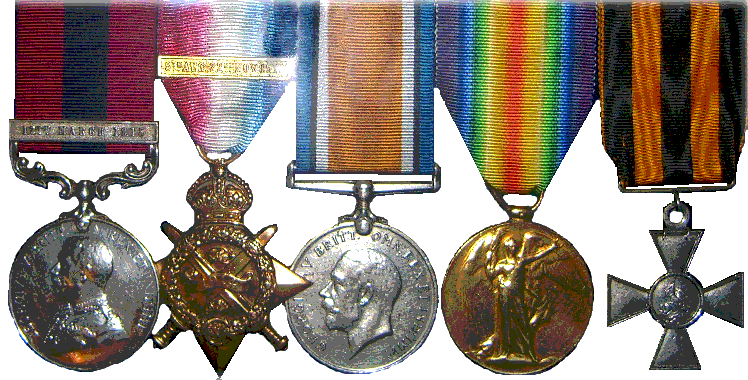
Medals of Sgt. William Mansell

